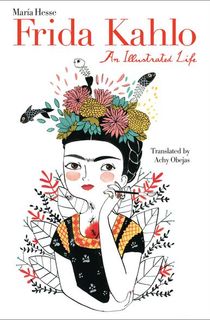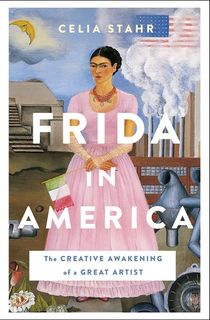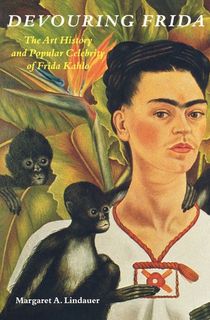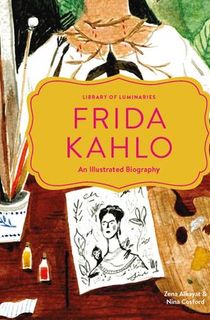Though it has been 70 years since her passing, she remains one of the most recognized Mexican artists of the 20th century. Even if you aren’t well acquainted with the details of her life, you have most likely seen her iconic portrait before. A confident woman, often unapologetically staring straight at you, with a bold red lip; her hair in an updo adorned with vibrant flowers; and her large, dark brown eyes emphasized by her signature unibrow. Her name is Frida Kahlo.
A Mexican painter who has become an influential figure for the Chicano community, the LGBTQIA+ community, and the feminist movement, Frida Kahlo’s popularity is due not only to the aesthetics of her stunning paintings but also to her fearlessness to paint life as she experienced it, including all of the emotional and physical pain she endured until her death. Though her art is often described as surrealist, with magical-realist elements and heavily inspired by the Mexicanidad movement, Frida Kahlo adamantly disagreed: “They thought I was a surrealist, but I wasn’t. I never painted dreams. I painted my own reality.”
She painted through a traumatic bus accident at age 18 that would drastically change the trajectory of her life; she painted through various miscarriages throughout her tumultuous marriage with her most cherished love, which was nevertheless filled with numerous cases of infidelity on both sides, and she painted in the final years of her life, attending her first and only solo exhibition in Mexico, where she lay in a four-poster bed placed in the center of the gallery among the attendees, determined to be there despite being incredibly unwell.
Here, you’ll learn about the fascinating life of Frida Kahlo. As you come to understand her journey with art, you will witness her soul, which she courageously and impeccably captured on canvas.
Early Life and Education

Frida Kahlo, right, with her sisters, photographed by their father in 1916.
Photo Credit: Wikimedia CommonsBorn Magdalena Carmen Frieda Kahlo y Calderón on July 6, 1907, to a German photographer of Hungarian descent who immigrated to Mexico, where he fell in love with Kahlo’s mother of Spanish and Native American descent, Kahlo was raised along with her two older sisters, Matilde and Adriana, and one younger sister, Cristina, in Coyoacán, a neighborhood in Mexico City, Mexico. Kahlo spent most of her life in their family home known as Casa Azul or the Blue House, which was later turned into the Frida Kahlo Museum, now one of the most popular destinations in Mexico City.
The beloved daughter of her father, Guillermo, Kahlo shared a particularly close relationship with him compared to that of her strict, Catholic mother, Matilde. Kahlo’s father encouraged her to lead an active lifestyle—playing soccer, swimming and wrestling—to build up her strength after she contracted polio when she was six years old, which resulted in her right leg and foot growing thinner than her left.
Despite exploring her creative side at a young age with her father, who taught her about photography and allowed her to take drawing lessons with his friend, she was actually more interested in learning science, and in 1922, at 15 years old, she became one of the first 35 girls to be admitted to the National Preparatory School in Mexico City to study medicine, botany and social sciences. There she thrived academically and started to become politically active, joining a group of students known as the “Cachuchas” who shared similar political and intellectual views. Kahlo even began claiming that she had been born the year the Mexican Revolution began, which she maintained throughout her life. The leader of the group became her first love, Alejandro Gómez Arias, in 1923, whom she was involved with until 1928.
But before this, in 1922, Frida Kahlo first met the Mexican muralist Diego Rivera, while he was coincidentally painting a mural titled Creation within her school’s amphitheater. Kahlo is said to have become immediately infatuated with both the art-making process and the artist himself, whom she often visited throughout his time there. Neither of them knew that this was merely the beginning of their story together.
Frida Kahlo’s Bus Accident

Kahlo photographed by her father at age 18 in 1926.
Photo Credit: WikipediaOn their way home from school on September 17, 1925, Kahlo and Arias boarded one bus, then shortly after got off to look for Kahlo’s missing umbrella, eventually boarding a second bus that was more crowded and required them to be seated near the back. Minutes after they had taken their seats on a wooden bench, the bus driver attempted to pass an oncoming electric streetcar; instead, the streetcar crashed into the side of the bus, dragging it a few feet and killing several passengers instantly.
Arias had luckily remained largely unharmed, but Frida Kahlo was not as fortunate. When Arias found Kahlo, he witnessed a horrific scene; a piece of iron handrail had impaled her pelvis, puncturing her abdomen and uterus. The impact had somehow unfastened her clothes, leaving her nude; another passenger, most likely a painter, had been toting around a packet of powdered gold that had fallen over Kahlo’s bloodied body. When another male passenger pulled out the handrail from Frida’s body, Arias claimed, “Frida screamed so loud that when the ambulance from the Red Cross arrived, her screaming was louder than the siren.”
18-year-old Kahlo was left with numerous injuries: her spine was broken in three places, while her right leg was broken in 11; she had a fractured pelvic bone; a dislocated shoulder; a broken collarbone; and her right foot had been crushed. Against all odds, Kahlo survived, but not without experiencing immense pain during her slow recuperation and undergoing more than 30 surgeries, with the understanding that despite them, she would have to live with chronic pain for the rest of her life.
After one month at the Red Cross Hospital in Mexico City, following three months bedridden at home adorning a full-bodied plaster cast, Kahlo was not able to attend school during this time due to her injuries. To fight the depression, loneliness and boredom of her recovery, she began to paint. Her parents presented her with a portable easel and fastened a mirror underneath the bed’s canopy that allowed her to begin creating her first ever notable self-portrait, Self Portrait in a Velvet Dress, which she would complete the following year in 1926, gifting it to Arias in hopes of capturing his affection once again—ultimately, futile as he left for Europe in 1927, bringing an end to Kahlo’s first serious relationship.
Frida and Diego

Diego Rivera and Frida Kahlo in an undated photo.
Photo Credit: Wikimedia CommonsKahlo’s earliest paintings were mostly of herself, her family members and her friends and were inspired by European Renaissance artists such as Sandro Botticelli and Bronzino. Kahlo began taking elements from avant-garde movements like Cubism to express her exploration of self: questions about her identity, pain from her altered reality and her musings on existentialism were wells of creativity that moved her to create art. During this time, she also became politically reinvigorated and joined the Mexican Communist Party, becoming close with the photojournalist, Tina Modotti. In 1928, at one of Modotti’s parties, Kahlo was reintroduced to Diego Rivera, whom she boldly asked based on the paintings she presented to him, whether she was talented enough to paint professionally. Thoroughly impressed by Kahlo, this began their reacquaintance, leading to their eventual union in 1929.
An unlikely coupling to most, even Kahlo’s mother wasn’t thrilled by the news of their relationship, describing the marriage between the unsightly man, 21 years her daughter’s senior, as “a marriage between an elephant and a dove.” Nevertheless, the newlyweds seemed happily in love, and soon Kahlo began to alter her personal style as well as her painting method. She started wearing traditional Tehuana attire: flowered headdresses, ornate jewelry, loose blouses and long skirts—an appearance that reflected her burgeoning interest in Mexican folk art that was beginning to emerge within her paintings. Kahlo’s 1931 Colonial-style wedding portrait, titled Frieda and Diego Rivera, completed two years into their marriage, depicts the couple in a flatter, more abstract style, presenting them as a traditional Mexican husband and wife.
Time in the United States
As newlyweds, they spent time in Cuernavaca, Mexico, but by 1930, they moved to the U.S., traveling for three years to different cities depending on Rivera’s commissions for his murals. They lived in San Francisco, New York and Detroit for a period while Rivera painted. Throughout these years, Kahlo was learning to hone her style and paint about painful experiences she was undergoing. By this time, Kahlo, who wished to have children with Rivera, had not been able to carry a child to term due to her prior bus accident. This reality was devastating for Kahlo, who decided to paint about the miscarriage she experienced in Detroit in a work titled Henry Ford Hospital in 1932, which features Kahlo sprawled on a bed naked, bleeding on a white bedsheet while six objects hover around her, signifying the loss of her pregnancy while mixing elements of reality and fantasy. Incredibly intimate, female artists had very rarely painted art about this painful, emotional and physically exhausting process, but Kahlo never shied away from showing the dark side of her experiences and the true reality of losing a child that she had been excited to raise.
During this year, Frida Kahlo’s mother also passed away, which is said to have inspired the artist’s painting My Birth in 1932, which depicts a woman in labor with a white sheet covering her face and an infant who resembles Kahlo exiting the womb. Above the bed is a painting of the “Virgin of Sorrows,” who appears troubled by the scene. In these paintings, Kahlo opted for art that was in the style of ex-voto retablos, paintings made on metal sheets with Catholic imagery that were used for devotional purposes, often depicting miracles. By utilizing this form, despite being an atheist herself, Kahlo creates a subversive message implying the complicated dichotomy of birth as a symbol for both life and death. Retablos usually include a scroll with a description of the miracle taking place, but in this painting, the scroll has been intentionally left blank to further demonstrate the lack of beauty within this birth; choosing to emphasize the pain and loss that can be associated with the process rather than what is usually depicted in popular culture.
In 1933, the couple returned to New York after Rivera was commissioned by Nelson Rockefeller to create the mural Man at the Crossroads, but due to Rivera’s controversial inclusion of Vladimir Lenin in his mural, he was criticized, and his painting was eventually destroyed, leaving Diego Rivera extremely frustrated and eager to continue fighting for his creative expression. However, Frida Kahlo, who was awfully homesick by this time, decided that they should leave America and live in San Angel, Mexico, much to Rivera’s disappointment and resentment.
Return to Mexico
Their union was far from ideal; Rivera and Kahlo had been engaging in affairs throughout their relationship. When they moved to San Angel, they lived in separate houses that had a small bridge between them to give each other much-needed space as individuals. Although both had been unfaithful, by far the worst betrayal would come from Rivera, who decided to have an affair with Kahlo’s favorite sister Cristina. In a form of rebellion, Kahlo cut off her long hair, stopped wearing the traditional Mexican garb Rivera adored, and moved into her own apartment. Kahlo has famously claimed, “There have been two great accidents in my life. One was the train, the other was Diego. Diego was by far the worst.” But regardless of the pain they endured from one another, the two were never able to completely sever ties.
In 1937, the couple provided sanctuary to the exiled Leon Trotsky and his wife Natalia Sedova, who resided for two years at La Casa Azul. During this time, Trotsky—whom she referred to lovingly as “El Viejo” (“the old man”)—and Kahlo engaged in an affair,, but it eventually fizzled out. Kahlo held no shame when it came to who she loved and was very sex-positive. The affairs she had during her life included relationships with both men and women who were captivated by her magnetic, playful and lively energy, which always surprised others who presumed someone with such immense physical ailments would be reserved, boring and solemn.
Nevertheless, these various entanglements always ended with Kahlo and Rivera back together, even after one of the darkest periods of Kahlo’s life when Rivera asked for a divorce in 1939. Frida returned from New York having impressed the leader of the Surrealist Movement, André Breton, who connected Kahlo with art dealer Julien Levy, responsible for organizing her first solo show at his gallery in 1938. After six months abroad, with a short stay in France where Kahlo became friends with famous artists Pablo Picasso and Marcel Duchamp and became the first 20th-century Mexican artist whose work was included in the Louvre’s collection, Kahlo ultimately grew tired of the Surrealist artists there, whom she found overly pretentious and consequently insufferable. Upon returning to Mexico, she was met with the horrible reality of separation from Rivera. Yet another heartbreaking portion of her life that once again deeply influenced a transformation within her identity and art.
Kahlo’s Art Influences and Most Notable Works
Throughout her life, Kahlo’s art changed alongside her. Though her early influences were those of European artists, as she further developed her style, she began to celebrate elements of Mexican folk art. Fascinated with the Mexicanidad movement that pushed back on the idea that Mexican art was inferior to European art, she thus began dismantling a colonial mindset that opened her up to the possibility of including various Mexican symbols, applying different modes of painting and highlighting figures from Mexican folklore within her art.
Utilizing pre-Columbian iconography like monkeys, skulls and hearts, along with Christian motifs and inspired by significant female figures who represent suffering and judgment, such as La Llorona and La Malinche, Kahlo used established symbols of Mexican society to create personal works of art that started societal conversations around gender, race and social class. Like Aztec mythology, Kahlo was interested in depicting a sense of duality in her art, as her paintings almost always portrayed opposites: life and death, Mexican and European or feminine and masculine elements. Kahlo was also known for including medical imagery within her self-portraits to express how her body often felt like a prison as her health deteriorated.
A Controversial Artist
Even though Kahlo’s style would change throughout her career, the one aspect that remained constant was her commitment to painting honestly about both the beautiful and hideous nature of life. She painted what she wanted and didn’t mind if others thought it was too bizarre, gruesome or unsettling. This often led to controversial paintings that some appreciated and others loathed. For instance, in 1938, Clare Boothe Luce commissioned a “Recuerdo” (remembrance) portrait of their deceased friend Dorothy Hale, who had tragically committed suicide by jumping from the top window of her luxury apartment in New York. Luce planned on gifting the portrait to Hale’s grieving mother, until she received the painting and realized that Kahlo had decided to paint the heartbreaking moment of Dorothy Hale’s death in a work titled The Suicide of Dorothy Hale, which understandably came as a huge shock to Luce, who was expecting a conventional portrait.
During Kahlo and Rivera’s brief separation in 1940, Kahlo painted another controversial painting, but this time, it was scandalous because Kahlo was depicting herself as challenging traditional femininity. The painting, Self-Portrait with Cropped Hair, is often described as Kahlo’s act of rebellion toward Rivera since it portrays her as having cut off the long tresses that Rivera loved, opting for a more “masculine” hairstyle, while she wears an oversized suit similar to one her ex-husband might have worn. Her hair, a symbol of her “feminine” identity, is strewn across the floor and also clings to the yellow chair in which she sits stoically. Kahlo defiantly wears a dangling earring, a heeled shoe and light makeup, as if to accept her androgynous identity, while also grieving her past title as Rivera’s wife.
Before that, in 1935, when Frida Kahlo learned of the ultimate betrayal between her husband and sister, she painted A Few Small Nips, one of her most horrific and gory pieces, as it depicts a naked woman, dead from multiple stab wounds, and a man, presumed to be the woman’s partner, standing above her holding a knife, placed within a “bloodied” wooden frame that Kahlo stabbed multiple times. Above them, two birds, one white dove and one black swallow, representing the innocent and torturous aspects of love, carry a scroll that reads, “A few small nips!” This sardonic piece is based on a news report Kahlo read about a man who had stabbed his girlfriend to death after learning of her unfaithfulness, then defended his actions by claiming, “But all I did was give her a few small nips!” Although this painting can be taken as a personal piece in response to Kahlo’s agony due to her cheating husband, it also becomes a brilliant political painting that critiques the normalcy of the brutalization of women due to machismo culture or toxic masculinity prevalent within society.
Back At La Casa Azul
No longer married to Rivera, Kahlo moved back to her childhood home, where she had a newfound resolve to earn her own living. Rather than continue with the small-scale paintings on tin sheets that she had been using since the early 1930s, she opted for large canvases that would be easier to sell and exhibit. One of her most famous works was painted in 1939 and was also the largest of her paintings. The Two Fridas (5.69 x 5.86 feet) is an oil-on-canvas double self-portrait of Kahlo seated on a bench holding hands with herself. The version of herself on the left wears a European-style wedding dress and appears to have snipped a blood vessel with surgical scissors, allowing a steady trickle of blood to stain her dress. The figure on the right has on a traditional Tehuana outfit and is holding a small picture of Diego as a child, which is attached by the artery that runs between the two Fridas. Though both figures have their hearts exposed, the Frida on the left reveals the inner workings of the organ, while the heart on the right is whole. The piece may signify her biracial identity and the loneliness and heartbreak of her recent separation from her love, Diego.
In 1947, the Instituto Nacional de Bellas Artes (National Institute of Fine Arts) in Mexico City purchased the painting for 4,000 pesos (around $1,000) which was the highest price Frida ever sold her paintings for while she was alive. Now her paintings are worth millions, like her painting Diego and I whichwas sold for a record $34.9 million in 2021, the highest price paid at auction for a Latin American artist, a record that was previously held by Diego Rivera whose art sold for $9.67 million in 2018.
Kahlo’s Later Years
By 1940, Kahlo and Rivera had reconciled and remarried a few months after news broke of Trotsky’s murder. Kahlo was brought in for questioning since she had known the murderer and was held for two days along with her sister before she was let go by police. Throughout the 1940s and 1950s, Kahlo’s health worsened; she needed to wear supportive metal back corsets for her spinal problems, had an infectious skin condition and suffered from syphilis. When her beloved father died in 1941, she became even more depressed.
In spite of this, Kahlo’s art was becoming more popular with international collectors; hence, she was invited to various group shows in America and Mexico, including Peggy Guggenheim’s Art of This Century Gallery in New York for the Women Artists show in 1943. During this time, Kahlo also accepted a teaching position at a painting school, Escuela Nacional de Pintura, known as La Esmeralda in Mexico City, where she referred to her dedicated students as “Los Fridos,” whom she deeply cared for. She taught her apprentices practical painting skills, but most importantly, to have a love for the craft.
After a failed spinal surgery in 1950, Kahlo was confined to a wheelchair, and in 1953, organized by her friend Lola Álvarez Bravo and hosted at the Galería de Arte Moderno, Kahlo was invited to exhibit her work at her first and only solo exhibition in Mexico. Though her doctor insisted that she stay home in bed since her health was quickly deteriorating, Kahlo chose to follow the doctor’s orders instead by traveling to the event in an ambulance and lying in her four-poster bed in the middle of the gallery to witness her show in person surrounded by friends, family and fans of her art—proving she would be stubborn and live by her own terms until the very end.
Later that year, Kahlo’s right leg developed gangrene and had to be amputated; the animated, vivacious woman became dependent on painkillers and drank heavily, hardly leaving La Casa Azul, though she continued to be politically active up until 11 days before her death, participating in a demonstration against the United States' intervention in Guatemala. In her last days, Kahlo had bronchopneumonia and began drawing sketches of the Angel of Death in her journal, anticipating that her life would soon be coming to an end.
Viva la Frida
Frida Kahlo’s last painting was Viva la Vida, Watermelons, completed eight days before she passed away on July 13, 1954, from a pulmonary embolism. Some question if this cause of death is accurate since her body was never autopsied. Kahlo is also suspected of having committed suicide. Allegedly Kahlo had given Rivera a wedding anniversary gift a month in advance, the evening before her passing, and her nurse had discovered that Kahlo had taken more painkillers than had been prescribed to her that same night. Frida Kahlo was only 47 years old. In her journal’s final entry, Frida Kahlo wrote, “I hope the exit is joyful—and I hope never to return.”
Her last painting features rich colors of various watermelons, some whole, while others are cut open. On one of the pieces of watermelon, she has written, “Viva La Vida” (or “Long Live Life”). Like her other pieces, individuals can interpret this painting in various ways. Some may deem it as a simple, yet powerful, celebratory farewell, while others may find the words satirical coming from a woman with a dark sense of humor who endured incredible amounts of pain during her lifetime. Maybe it is intended to be both.
In her honor, Rivera allowed La Casa Azul to become a museum that opened in 1958, a year after Rivera passed away. His last painting before his death three years after Frida, The Watermelons, was undoubtedly an homage to his deceased love.
Presently, Frida Kahlo is one of the most recognizable artists, whose image inspires others to create merchandise and art known as the “Fridamania” phenomenon, a commodification of Kahlo that has been both celebrated and critiqued. Her life story and the deep meanings behind her paintings allowed her to become a symbol for the marginalized, the non-conformists and those deemed powerless in society. Kahlo was a painter who defied expectations over and over again and an artist who painted for herself, but in doing so painted for millions of others, whose tragedies, joys and personhood are validated whenever they come across her paintings. For many, she has become an emblem of strength and hope, but I think Frida Kahlo describes her refusal to allow any kind of limitation to hinder her the best: “Feet, what do I need you for when I have wings to fly?”




